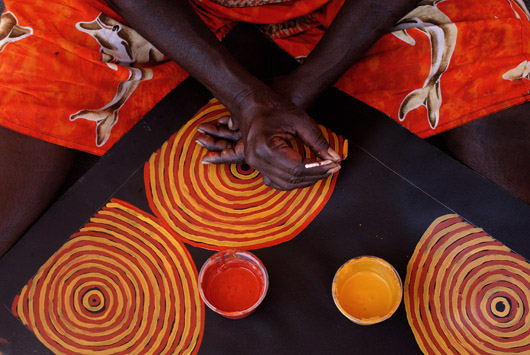Australia,
sulle tracce di Chatwin venti anni dopo Le Vie dei Canti
Palazzo Ducale, Genova
Australia, on Chatwin's footsteps twenty years
after The Songlines
Palazzo Ducale, Genoa


Puntinature
cromatiche, forme minimaliste, semplici acquerelli. Astrazioni simboliche,
strutture intricate, tendenze figurative. Agli occhi del visitatore di
passaggio, la pittura è l’ambito in cui sembra che gli aborigeni
si esprimano con più felicità. Un fatto sociale che appare
trasversale. Si va dal dilettante che prova a fare il salto sul mercato
agli artisti riconosciuti a livello internazionale che fanno registrare
vendite milionarie, fino a chi si improvvisa pittore per piazzare qualche
patacca all’ingenuo di turno. Racconti del sogno, trasmissione di
tradizioni, ma anche business. Chatwin stesso dedica un capitolo non tenero
ad alcuni “mercanti d’arte aborigena” di Alice Springs.
Vi sono diverse cooperative e associazioni che organizzano il lavoro degli
artisti aborigeni, spesso con whitefella (bianchi) in posti chiave. Ad
Alice la Ngurratjuta Pmara Ntjarra Corporation raggruppa una trentina
di artisti tra cui Lennie Namatjira, nipote di Albert Namatjira, il più
importante pittore aborigeno. Dipinge accanto alle compagne, sedute per
terra a gambe incrociate, chine su tele e vernici acriliche che hanno
sostituito i pigmenti naturali e il corpo o la pietra. Racconta del suo
stile, finisce per parlare del nonno che continua a ispirarla. Per il
valore della sua arte, lodata anche dalla regina d’Inghilterra,
e la fama acquisita, Albert fu il primo aborigeno ad avere la cittadinanza
australiana, nel 1957. Ma le cose cambiarono rapidamente. Venne accusato
di fornire alcol illegalmente, perché da libero cittadino comprava
ogni tanto da bere agli amici secondo la consuetudine comunitaria. Rivendicò
la sua innocenza, ma fu condannato a sei mesi. Uscito dopo due mesi di
prigione, cadde in depressione e non dipinse più. Si spense qualche
mese più tardi, a 55 anni, per un attacco di cuore

